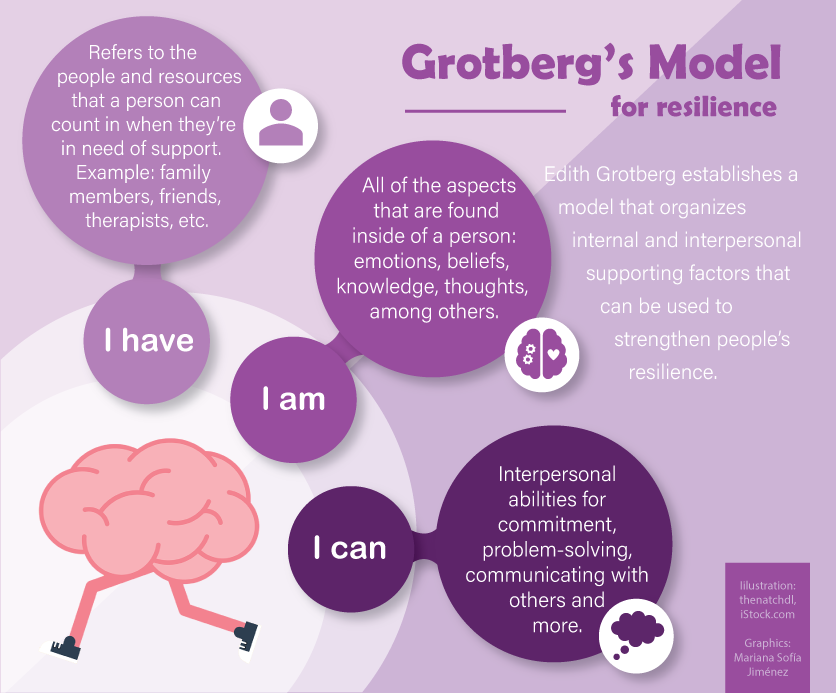The Merriam-Webster Dictionary defines resilience as “an ability to recover from or adjust easily to misfortune or change.” That sounds limited to extreme occurrences, such as how to act when a black bear approaches you on a mountain hike or the steps to stay safe during a flood. However, resilience goes beyond survival, significantly benefiting people’s integral development.
Resilience is also about personal growth. It is the ability to recover from complicated conditions or obstacles that hinder the achievement of one or more goals. Threats and challenges will inevitably appear throughout life, but having the tools to address them is the best way to avoid feeling defeated by discouraging situations, overcome them rapidly, learn from them, move forward, and prepare for the future. Resilience is a skill that encompasses and stimulates many other virtues, such as optimism, flexibility, high self-esteem, perseverance, creativity, reflection, and discipline, among others.
Moreover, strong resilience enhances people’s mental health and well-being. The power to recover from adversity quickly improves the management of emotions and reduces symptoms of depression and anxiety.
It is an aptitude that we all possess. However, each person’s resilience level is different due to their social, economic, and possibly genetic background, so its development will be faster in some individuals than others. Resilience can be learned in homes, schools, and through self-imposed strategies. Like in the gym, where we strengthen our muscles by gradually increasing weights, we can train our brains to cope with various expected and unexpected situations.
Work on your resilience!
Planning, organizing, developing awareness of our thoughts, and having clear goals are the first steps toward stronger resilience. To exercise it (given that you cannot always foresee undesired results in the future), begin by considering your current goals and make an action plan to get there. Here is a short questionnaire to help you achieve your goals:
- What is your goal? How long will it take you to accomplish it?
- What are the steps required to achieve that goal? List them.
- What obstacles or challenges might prevent you from accomplishing the goal? Write down as many as you can conceive; consider which are the most relevant.
- Develop a strategy with the steps to follow to attain your goal, minimize potential obstacles, and include an action plan to cope with unexpected challenges.
- Implement your strategy.
Note that these steps may not necessarily work for big goals such as learning a language fluently or painting like a Renaissance artist. However, they are helpful with smaller goals, such as exercising more frequently or organizing a school project; furthermore, attaining small objectives can lead to accomplishing a bigger goal.
American writer Edith Grotberg proposes a model to increase resilience in children. However, it can be a relevant model for any age, guiding people to identify their sources of support and abilities to cope with any situation:

It is essential to know and identify everything that is inside and outside our control. Through the Chief Executive platform, Eric Potterat and Alan Eagle make an intriguing analogy concerning this. Imagine being inside a circle where our thoughts, behavior, actions, and abilities surround us. Outside the circle is everything else: an event, other people’s actions, regulations, etc. Developing resilience means having the serenity and awareness of what we can do with what we have inside the circle to face problems while understanding that everything outside is beyond our control.
A positive attitude allows us to see bad situations as learning opportunities; rising defiantly from a fall strengthens resilience. However, it’s not just about having a particular attitude; it is about reflecting, adjusting, and changing specific aspects to cope with similar occurrences in the future.
Martha Beck, an American writer, describes resilience thus: “By definition, it doesn’t describe a state of never falling, never getting hit. In fact, to be resilient, we have to experience crushing forces. We have to let ourselves absorb those forces, then rebound in a way that uses them to our advantage.” However, we are not always under challenging situations and cannot force them. Therefore, leveraging situations in work or educational environments is an excellent way to build muscular resilience: expressing our opinions in class, proposing ideas in a meeting, speaking in public, and joining a class outside our comfort zone are some ideas to start building resilience.
Resilience in the Classroom
This skill is essential in education. Providing students with classroom activities to practice and strengthen their resilience helps them reduce negative feelings and refuse to give up in the face of adversities they encounter throughout their academic and professional lives.
“When educators help students “cultivate an approach to life that views obstacles as a critical part of success, we help them develop resilience,” says Marilyn Price-Mitchell, psychologist and author. Implementing this skill in the classroom fosters teamwork, adaptability, innovation, and leadership. In the same way, integrating activities and modalities that promote resilience benefits individual students and the classroom environment.
How do you boost resilience in the classroom? Here are some ideas:
- Individual and collaborative reflection activities help students identify challenges, actions needed to resolve them, and improvements to the solution. These activities can be around a reading, school assignment, or project.
- Making mistakes is natural, so fostering an environment that cultivates understanding and motivation will help students normalize failures and mistakes as an essential part of their learning. They will feel encouraged to participate more and try new things. For example, when asking questions in the classroom, affirmative and encouraging words will help students lose their fear of committing errors.
- Celebrating progress over results encourages students to continue their learning journey. This way, they understand that success is rewarded and their efforts are just as valuable.
- Encouraging goal-setting helps students understand that everything is a process and that achieving a goal does not occur instantly. For example, breaking down a long project into smaller phases can help students feel more relaxed about completing it and understand that complex projects take time.
Resilience is not just a response or defense mechanism to unfortunate mishaps; it is a way to thrive despite them, using negative experiences as lessons to enrich a person’s development. It is almost impossible for everything to go well on the first try or to know how to respond correctly to unwanted events. Every famous figure has faced failure before achieving success throughout their career, so getting used to it is an indispensable skill for everyone. Trying repeatedly until you reach your goal is the key to success. As Thomas Edison said, “I have not failed. I’ve only found 10,000 ways that don’t work.”
Translation by Daniel Wetta
This article from Observatory of the Institute for the Future of Education may be shared under the terms of the license CC BY-NC-SA 4.0 
)
)


)